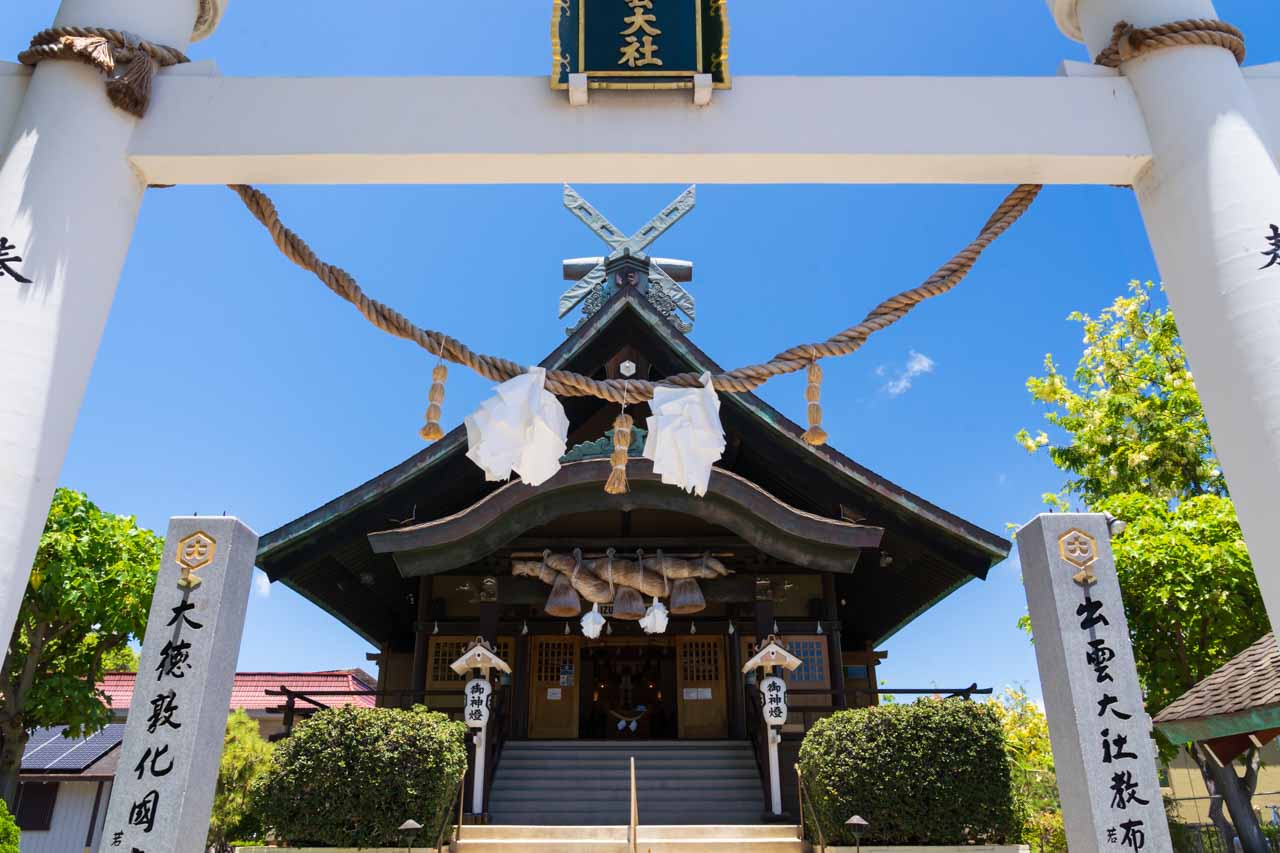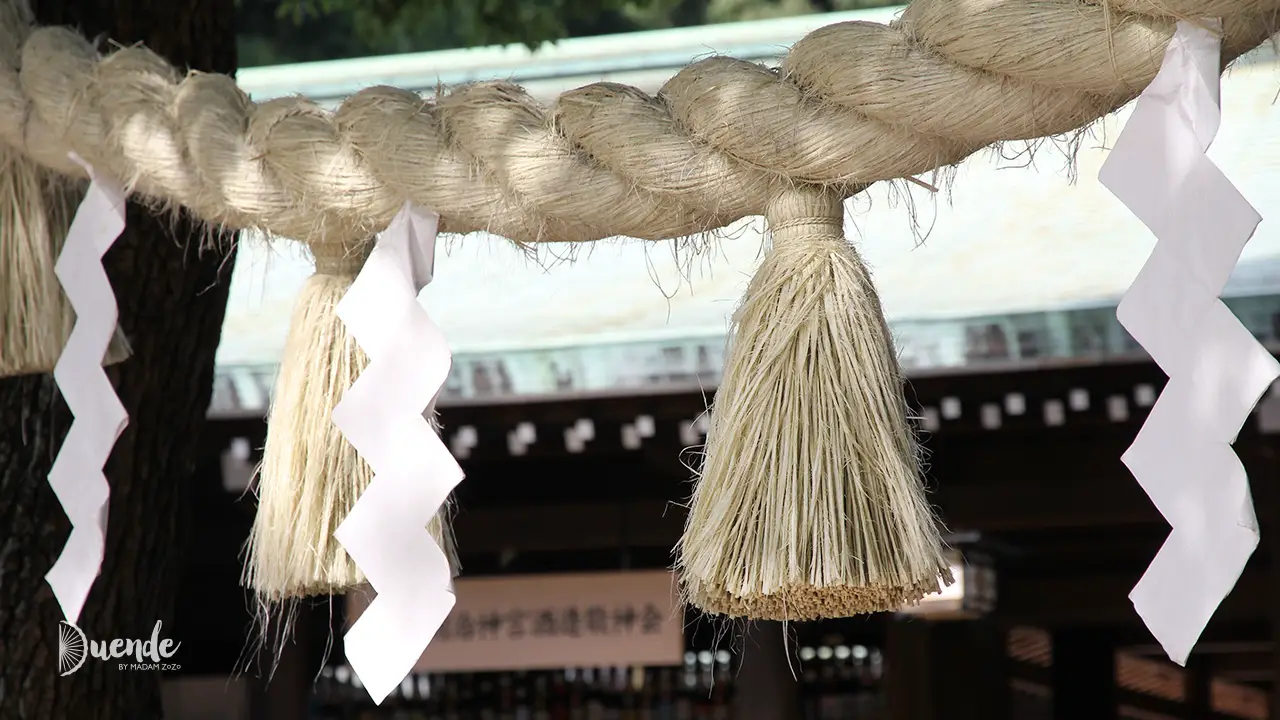It happened by accident that our visit to Meiji Jingu (shrine) coincided with the 163rd anniversary of Emperor Meiji’s birth and within the bounds of the Grand Autumn Festival that celebrates Emperor Meiji’s legacy. While we explored the shrine buzzing with locals eager to pay their respects to the popular former leader and his wife, Empress Shōken, I was distracted by a pair of trees in the corner of the courtyard.
The two towering Camphor trees that had my attention were joined by a curious-looking rope embellished with zigzag-shaped streamers. I snapped away with my camera, unaware of the significance of the setting but certain a little research would reveal the meaning of shide and shimenawa.
Shide to the shimenawa
Shide (pronounced “she-day”), are folded, white streamers that are generally used in 3 ways, each with their own name:
- Shide or o-shide if you are being super polite, are hung over public shrines and above private altars. Shide are usually attached to a sacred rope—shimenawa.
- Harai gushi are when many strips are attached to a wand and waved by a Shinto priest to sweep away bad spirits. In Japan, it is common for a new car, or building site to be purified this way.
- Go-hei again involves attaching the paper strips to a rod but must be made by the priest. They are stood inside a Shinto shrine both as an offering to and representation of the deity being honoured.

The meaning of shimenawa
Like the red velvet ropes strung along red carpets or nightclub entrances, in the ancient Japanese religion Shinto, shimenawa are rice straw ropes used to separate the rabble from the V.I.Ps. The sacred braids are used to cordon off areas of purity or significance, where heavenly and earthly worlds meet.
They are hung across Shinto shrine entrances, demarcate ceremony locations and are worn as belts by sumo grand champions as they enter the ring. Shimenawa can be found wrapped around statues, legendary trees, rocks and anything thought to be inhabited by god-like beings called kami.
This takes us back to the two camphor trees in the courtyard at Meiji shrine. The handsome pair have been married off as myotogi—couple trees—united through the earth. They are a popular place for singletons to pray for a good match, and couples for a peaceful union.
In Japan, it is believed that Emperors past become kami. It isn’t clear to me whether the spirits of Emperor Meiji and his faithful Empress are thought to inhabit these trees, or whether it’s just the cosy proximity of their growth that marries them. One thing is for sure, the camphor couple stand mighty in Meiji Jingu just as Emperor Meiji and Empress Shōken stand tall in the hearts of the Japanese.
How to make shide and shimenawa
In the following video, a Japanese gentleman demonstrates the traditional method of making shide and shimenawa.
I hope you enjoyed learning about the origin and meaning of shide and shimenawa. If you’d like to read more discoveries of Japan culture, check out Kawara: Decoding Japanese Roof Tiles and Even Samurai Grow Flowers – The Story of Japan’s Chrysanthemums.
Peace, love & inspiring travel,
Madam ZoZo


3 comments
I take issue with the lack of journalistic explanation regarding the topic of the lightning symbolism. Simply stating that the interpretation of shide relating to lighting is a “purely western” idea, then offering no specifically Japanese or “eastern” explanation as to their possible symbolism, or lack thereof, is quite disappointing. To the point of the lightning symbolism tho, I find it hard to believe that it is purely western especially when Raijin (Shinto god of lightning and thunder) is among the main pantheon for Shinto kami. Furthermore I have read that it was considered good luck when the rare lightning bolt would strike an already sown rice field and that the location of the strike would be cordoned off be shimenawa with shide. All this accompanied by many sources relating lightning to prosperity, in some form or another, throughout Japanese culture. If this article was meant to be a vessel for the provided video—just a cute and crafty look at a Japanese ceremonial item, sure. Great. But if this was mistakenly meant to be a source of any substantial or in-depth information on Japanese tradition or Shinto spirituality, it has fallen short.
Hi Jimmy,
I appreciate your feedback on this post.
I am in no way an expert on Japanese culture and this post wasn’t intended to be encyclopedic. It was merely meant to satisfy the curiosity of the average traveller who may see shide and shimenawa while travelling in Japan and wonder what they were.
I wanted to be clear that my first impression and description as “lightening” came purely from my observation of its form and not from any deeper cultural knowledge or understanding. I’ve been wrong about applying my western interpretation to other cultures before and have learnt to step back and gain more context before drawing conclusions. With that said, I agree the post needs re-wording to make that more clear.
I actually found it quite difficult to find a reliable source of information about shide and shimenawa in English, or this post might have been a lot longer.
Thanks for visiting Duende.
Zoe aka Madam ZoZo
Today I finally learned what the very aesthetically pleasing and uniform zigzag papers hanging from japanese ropes, usually on torii gates and from girl’s traditional panties such as Jubei’s skimpy panty in Hyakka Ryoran Samurai Girls, is called. They are “Shide”!! I’ve heard before they are also called lightning shaped paper, maybe in Monogatari! ⚡